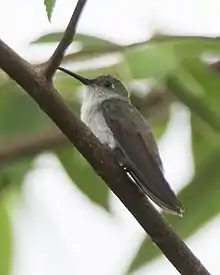Olive-spotted hummingbird
The olive-spotted hummingbird (Talaphorus chlorocercus) is a species of hummingbird in the family Trochilidae. It is the only species placed in the genus Talaphorus. It is found in western Brazil, Ecuador, Peru and far southeastern Colombia.
| Olive-spotted hummingbird | |
|---|---|
 | |
| Scientific classification | |
| Kingdom: | Animalia |
| Phylum: | Chordata |
| Class: | Aves |
| Order: | Apodiformes |
| Family: | Trochilidae |
| Genus: | Talaphorus Mulsant & Verreaux, 1874 |
| Species: | T. chlorocercus |
| Binomial name | |
| Talaphorus chlorocercus (Gould, 1866) | |
Its natural habitat is subtropical or tropical moist shrubland.
This hummingbird was previously placed in the genus Leucippus. A molecular phylogenetic study published in 2014 found that Leucippus was polyphyletic. To avoid the polyphyly the olive-spotted hummingbird was moved to the resurrected genus Talaphorus.[2][3][4]
Description
The olive-spotted hummingbird is 8 cm in length, dull metallic green above, crown slightly browner, with a white postocular spot. It is whitish below, throat with a few olive spots, sides washed greenish. Tail green with grayish tips on outer feathers.[5]
References
- BirdLife International (2012). "Leucippus chlorocercus". IUCN Red List of Threatened Species. 2012. Retrieved 26 November 2013.CS1 maint: ref=harv (link)
- McGuire, J.; Witt, C.; Remsen, J.V.; Corl, A.; Rabosky, D.; Altshuler, D.; Dudley, R. (2014). "Molecular phylogenetics and the diversification of hummingbirds". Current Biology. 24 (8): 910–916. doi:10.1016/j.cub.2014.03.016.
- Stiles, F.G.; Remsen, J.V. Jr.; Mcguire, J.A. (2017). "The generic classification of the Trochilini (Aves: Trochilidae): Reconciling taxonomy with phylogeny". Zootaxa. 4353 (3): 401–424. doi:10.11646/zootaxa.4353.3.
- Gill, Frank; Donsker, David; Rasmussen, Pamela, eds. (July 2020). "Hummingbirds". IOC World Bird List Version 10.2. International Ornithologists' Union. Retrieved 6 January 2020.
- Ridgely, Robert and Paul Greenfield. The Birds of Ecuador. Volume II: Field Guide. Cornell, 2001
